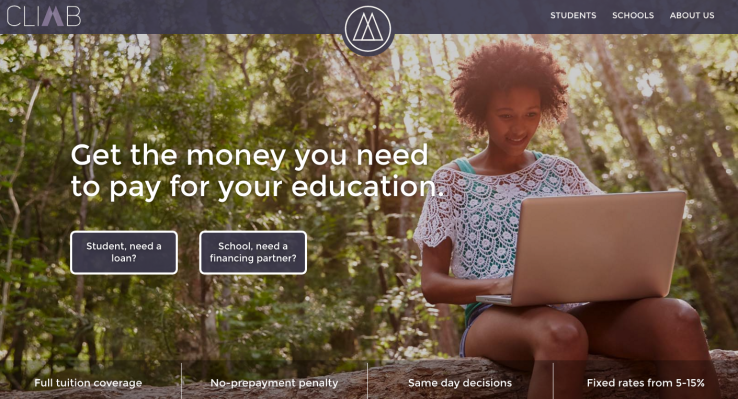
Climb Credit looks to transform student lending with a new business model based on graduate success
By Jonathan Shieber for Techcrunch.com
The U.S. is facing a crisis in higher education.
Once the ticket to the middle class life at the center of the fabled “American Dream”, the college and university experience is now under attack from all sides. Education hasbecome pricier, while graduates are less prepared for jobs in either the white collar orblue collar workforce.
Meanwhile, critics deride the value of a liberal arts education, teachers are underpaid, and unnecessary spending on top-of-the-line recreational facilities, student unions, residence halls and stadiums is maxing out college budgets in exactly the wrong way.
The student loan crisis by itself (a response to the rising costs of education) is going to be a drag on the national economy for years to come. In the summer of 2015, the collective student loan debt sat at around $1.3 trillion and that number could double by 2025.
Money that’s used to pay down loans is money that’s being pulled from other places in an economy, namely buying houses, saving for retirement, or, really, anything else. Imagine if that $1.3 trillion was flowing through the economy and what that could mean for the U.S.
The nightmare scenario was laid out in all its gory details in a January article from Allie Conti in Vice:
The worst-case long-term scenario is that their debt will scare them away from taking out credit cards and building up a good FICO score, which will in turn prevent them from purchasing houses. Rents stay high, wages stay low, and money that might have gone into a retirement account or paid down a mortgage has over the years gone to paying for a degree.
A number of startups are trying to ease this burden on student borrowers by offering them easy ways to refinance loans at lower rates, or ways to take out loans at better rates initially. Companies like CommonBond, Credible, Earnest and SoFi are all helping to reduce the burden of student loan debt.
Climb Credit, a new entrant into the student lending market which just received a $400 million lending facility, is taking a different approach.
“We started Climb to fund what we call high ROI education,” says co-founder and chief executive Zander Rafael. “It’s education that actually works and benefits the student.”
The 31-year-old Harvard graduate and his co-founders Amit Sinha and Vishal Garg all saw the problems bedeviling higher education in the U.S.
“Most schools aren’t providing the value to the students that the students want and the employers want. Dropout rates are high, which leads to higher defaults, and even if you do graduate you don’t necessarily get the skills that you need,” Rafael says.
So Climb set out to change the model. The company identified schools that were doing things well — from charging lower fees, to directly linking training to the skills needed for future employment, to reducing spending on things like infrastructure in order to focus on student outcomes and teacher salaries.
That meant building out a school’s outcome database and using that database to underwrite the loans that the company makes.
“We find industries that make sense, where we know there’s a lot of demand for employment and we go out and we find students and judge their outcomes,” says Rafael. Currently, the company is partnered with roughly 40 schools that are operating from 70 campuses.
The schools that Climb works with run the gamut from medical training programs, industrial programs, and new undergraduate and masters programs like the Minerva Project.
Coding bootcamps are also another outlet, with Climb providing loans to students enrolling at General Assembly, The Iron Yard, and Galvanize.
These schools, while successful, have problems with accessibility. Even students who’d want to enroll in the programs often can’t because they can’t afford it.
Another twist on the traditional lending model is that Climb has managed to wring from the schools it’s working with an agreement that reduces the amount of loans a student has to pay back if they aren’t able to find a job.
Rafael and his co-founders aren’t new to the student loan business. The serial entrepreneurs previously founded MyRichUncle.com, a short-lived, much-ballyhooedstudent lender that went bust in the wake of the financial crisis in 2009. Trying their luck across the pond, the co-founders worked in England to establish FinanceMyFuture (nowFuture Finance).
Back in the U.S., Rafael and company set up Climb in 2014 and began laying the groundwork for Climb. “We weren’t sure we wanted to get involved,” says Rafael of the trio’s early exploration of the lending market in the U.S. “It wasn’t until we saw educational opportunities that were actually adding value to students,” that they began seriously thinking about the company.
So far, Climb has managed to wrap up a lending facility of up to $400 million from an undisclosed top-three global asset manager to make its loans. The company has also raised a small, $2 million venture round to fund its operations.
First appeared at Techcrunch.com





